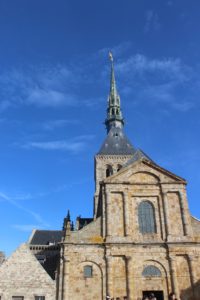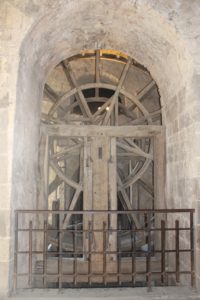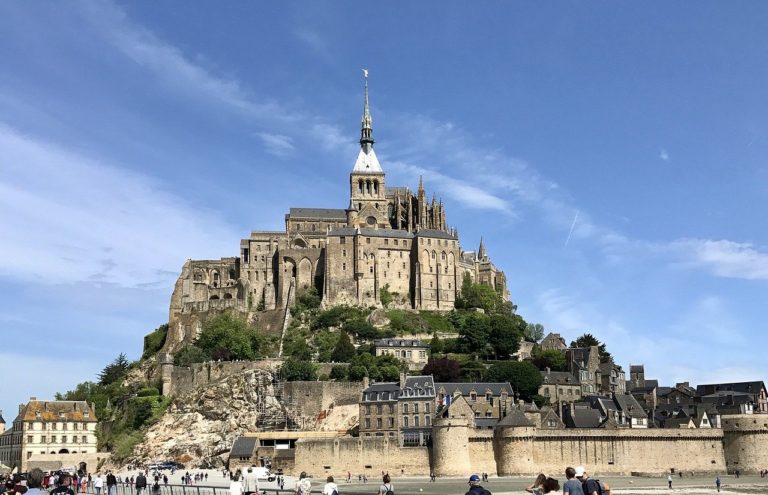Mont Saint Michel Abbey
There are several different ways to explore Mont Saint Michel abbey. You can take a guide tour or discover the abbey by yourself. If you’d prefer to go at your own pace then you can rent an audio guide that will guide you through the abbey. There’s also a leaflet you can pick up that explains the parts of the abbey open to the public.
The abbey is spread over three levels and there’s a route that you follow. Occasionally this route changes but it’s very clearly marked. The leaflet available in the ticket hall includes a map. You start your tour on the ground floor and then pass to the upper floor, the middle floor and return to the ground floor.
The entrance
At the entrance to the abbey, is a stone staircase. This will take you to a security point located in the original Guard Room. There may well be a queue of people here belonging to groups and tours. Groups take the left hand side of the staircase and individuals use the right hand side. Once through security, head for the ticket office on the right. At security bags will be scanned and you walk through an airport-style scanner to check you have no metal objects on you. You can buy an audio guide if required and pick up a leaflet. Retrace your steps to go back to the Guard Room. Then head over to another stone staircase once your ticket has been checked. You’re now on the lower floor of the building and are going to go up to the upper floor by-passing the middle level.
Climbing up to the top
The first part of the tour is outside although this only takes a few minutes. Climb up the wide stone stairs of what is known as Le Grand Degré which sits between the abbey buildings and the church. Look up and you’ll see suspended passageways built between the 14th and 16th centuries that linked the two sides. At the top of the stairs are some restrooms (currently the only ones here) and a small open area providing a great view towards the dam. Go through a small room where there are some models showing the development of the Mount. Walk outside and onto the west terrace. If the weather is good, so much the better as you’ll have great views here across the bay. Tombelaine and Mon-Dol are the two smaller islands you can see. Brittany is to your left and the Normandy coastline is to your right.
Before you head into the abbey church, take a look at the Neogothic spire of the church tower. It was built in 1897 and has a gilded statue of Saint Michel as it’s crowning glory.
The Church
Now head into the church and explore it before crossing a small room that leads to the cloister. Traditionally cloisters are the centre of an abbey but the Mont Saint Michel has buildings on only two sides. One side has three arched windows which give a wonderful view across the bay. The cloister leads directly into the refectory – a vast room with pillars down either side and a wooden vaulted ceiling.
The middle floor
You now leave the upper floor and walk down the stone steps to the middle floor. The first room you visit on this floor is La Salle des Hôtes (Guests’ Hall) which is directly underneath the refectory. This is another huge room which was designed for receiving royalty and nobility. From here, you walk through La Chapelle Saint Madelaine. Leaving here there’s a brief visit into the open air before you walk into a crypt (Crypte des gros piliers). This crypt was built in the mid 15th century and supports the Gothic chancel of the abbey church which is directly above. The large pillars and small windows make the crypt rather dark so head over to the right hand side of the crypt to the exit if you don’t want to linger too long here.
La Grand Roue
A short walk along a passageway leads to another crypt (Saint Martin). The crypt sits directly underneath the south arm of the abbey church transept. The visit then takes you to the big wheel (La Grande Roue) that occupies the former ossuary where human bones exhumed from churchyards were preserved. The wheel was installed around 1820 and was used to hoist provisions up to the inmates during the time it was a prison. It replaced pulleys that were used for hoisting building materials up the building during the middle ages. You can see where the pulleys were on the outside of the building if you look slightly towards the left hand side.
The North/South Stairs And Ambulatory
Another small chapel (Saint Étienne) leads on from here and was the chapel of the dead. As you leave the chapel, you climb another staircase (the north/south stairs) which is directly below the west terrace in front of the abbey church. At the top of the stairs turn right into a covered walkway which the monks used as an ambulatory. At the end of the ambulatory stairs lead down into La Salle des Chevaliers (the Knights’ Hall). This vast room was built to support the cloister which sits directly above it and was where the monks worked and studied.
Returning to the ground floor
To leave the middle floor, take the spiral stone staircase which will take you briefly into the other end of the ticket hall on the lower floor. This room is known at the almonry and was where monks received the poor as well as pilgrims. You then walk through into the gift shop and out into the open air. You’re now at the back of the Mount and can get a view of the small chapel at the base of the rock. Walk through the small garden and back out through a turnstile. If you turn right as you come through the turnstile you’ll be heading towards the Abbey entrance. Heading left will take you towards the ramparts and you can now explore the village.
For an in-depth behind the scenes view, watch this amazing video below. The team were given special access to secret passageways and hidden areas of the abbey including the belvedere, the bell tower, the prison and a second church. It’s a fascinating insight into those parts of the abbey that aren’t open to the public. It’s in French but sub-titled in English. You may need to click on the settings icon (the cog) to activate the subtitles. They also visit some of the parts of the abbey that are open to the public including the abbey church, the cloister, Salle des Hôtes and Salle des Chevaliers.
Read my top 10 tips for visiting Mont Saint Michel.










